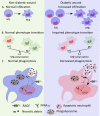Macrophage Dysregulation and Impaired Skin Wound Healing in Diabetes
- PMID: 32671072
- PMCID: PMC7333180
- DOI: 10.3389/fcell.2020.00528
Macrophage Dysregulation and Impaired Skin Wound Healing in Diabetes
Abstract
Monocytes (Mo) and macrophages (Mϕ) play important roles in normal skin wound healing, and dysregulation of wound Mo/Mϕ leads to impaired wound healing in diabetes. Although skin wound Mϕ originate both from tissue resident Mϕ and infiltrating bone marrow-derived Mo, the latter play dominant roles during the inflammatory phase of wound repair. Increased production of bone marrow Mo caused by alterations of hematopoietic stem and progenitor cell (HSPC) niche and epigenetic modifications of HSPCs likely contributes to the enhanced number of wound Mϕ in diabetes. In addition, an impaired transition of diabetic wound Mϕ from "pro-inflammatory" to "pro-healing" phenotypes driven by the local wound environment as well as intrinsic changes in bone marrow Mo is also thought to be partly responsible for impaired diabetic wound healing. The current brief review describes the origin, heterogeneity and function of wound Mϕ during normal skin wound healing followed by discussion of how dysregulated wound Mϕ numbers and phenotype are associated with impaired diabetic wound healing. The review also highlights the possible links between altered bone marrow myelopoiesis and increased Mo production as well as extrinsic and intrinsic factors that drive wound macrophage dysregulation leading to impaired wound healing in diabetes.
Keywords: bone marrow; diabetes; hematopoietic stem; inflammation; macrophages; monocytes; progenitor cells; wound healing.
Copyright © 2020 Barman and Koh.
Figures


References
Publication types
Grants and funding
LinkOut - more resources
Full Text Sources

